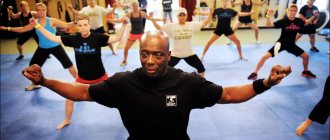Health running: programs and techniques[edit | edit code]
Source
: From 800 meters to marathon (Daniels)
Daniels' approach to helping those who want to become runners is to provide them with a series of training plans designed for people of varying fitness levels. He assigned different colors to these plans and designated the beginner plan as white. Once the white plan is successfully completed, the runner can move on to the next level, the red plan. Following the red are the blue and yellow plans, designed for more advanced runners. Please note that the word "advanced" does not necessarily mean "elite". He calls runners who put a lot of effort into their workouts advanced. Their competitive results don't necessarily have to be stellar, but their training is serious and their level of fitness is higher than most.
Each program is designed to allow individuals completing it to achieve some level of aerobic fitness. Having been involved in sports education and fitness for many years, I realized that health benefits are not fixed forever. The benefits of regular physical activity range from preventing disease and obesity to reducing medical costs and simply improving your overall well-being. If some non-elite runners feel better after following one or more plans, then I will know that my efforts have paid off. Those who complete the blue and yellow plans will be able to achieve a very high level of fitness, which will allow them to take part in some competitions if they wish.
Benefits and safety precautions
Run or walk
Many people ask, running or walking, which is better for health, which to give preference to. No doctor can give a direct, clear answer to this question. It all depends on many factors: the initial state of health, physical fitness or training, the presence of diseases, age, and weight. The differences between them are quite numerous.
- The load on the joints and spine is much higher than during normal walking. Therefore, people with excess weight are recommended to start with walking, and then gradually increase the intensity of training to avoid injury.
- Walking promotes a leisurely flow of thoughts, which is why it often does not work as a cure for stress right away. Athletes joke that you can escape from depression, but only at the ninth kilometer. On the other hand, walking will allow you to thoroughly think about the situation and make a choice of next steps.
- Strengthening muscles and burning fats occurs slowly when walking, but much faster during walking.
If a person has just decided to take care of his own health, then preference should be given to walking. But over time, it is imperative to increase speed, master new techniques, and increase loads. This way you can gradually achieve completely unexpected results that you could not even dream of.
Safety precautions
Beginners who have just taken up this sport often neglect basic safety rules. Because of this, at best they do not get the results they need, and at worst they end up with serious problems or injuries. This cannot be allowed, so it is better to learn them and never forget them.
- When going for a run far from home, take your mobile phone with you so you can call for help if needed.
- You should consume fluid while jogging. Be sure to get yourself a bottle of water for any time of year.
- Start any race with a warm-up, this is the only way to protect yourself from sprains and injuries.
- Ban yourself once and for all from running in inappropriate equipment. Incorrect clothing that makes you sweat or freeze will lead to frequent colds, when training will be impossible.
- Avoid headphones if you run in an urban environment, where there are a lot of other people, cars, dogs, playing children and other disturbances nearby. For example, not hearing a shout or a horn can cause harm not only to yourself, but also to those around you.
Following these simple rules will allow you to protect yourself as much as possible and enjoy running to the fullest.
Contraindications
Contrary to misconceptions, not everyone can run. There are prohibitions, bypassing which means making things worse for yourself.
- Hypertension or hypotension. Such pressure disturbances can cause unpleasant consequences when running, including rupture of blood vessels and stroke.
- Glaucoma.
- Heart disease.
- Flat feet in the absence of special shoes or doctor’s testimony.
- Phlebeurysm.
- Recent traumatic brain injury, concussion.
- Atherosclerosis.
- Pathological vitamin D deficiency (rickets).
- Rheumatic phenomena, arthritis, arthrosis.
Moon's disease, in which wasted fat cells grow at an even faster rate, will also be a contraindication against jogging. It is generally better to limit sports activities with her as much as possible.
https://youtu.be/u-1bDjEHSCk
White starting plan[edit | edit code]
Until you try running, you won't know how much fun it is.
I was inspired to start developing a running training program for people who either want to start running from scratch or want to get back into running after a long break, because of several factors.
One
One of them was my personal experience: I myself participated in an outstanding fitness program when I was in high school. We had physical education lessons for an hour every day for four years. We played many sports and games, and through this I learned to respect physical activity as an important part of growing up. As a result of this remarkable program, three of our class members competed in the Olympics just six years after high school—not because we emerged as sports stars, but because we achieved a high level of fitness.
Second factor
: I later studied and taught in Sweden, where I was amazed by the level of physical fitness of the students, especially compared to what I saw in my homeland and in many other countries. They took their health and fitness very seriously, and I would like to see this experience spread throughout the world.
Third factor
My interest in writing a program for aspiring runners came from my involvement for several years with the Leukemia and Lymphoma Society, which developed training programs to prepare ordinary citizens for the marathon. I had done research that showed the rapid benefits of regular aerobic exercise and wanted to make running more attractive to anyone interested in improving their health and aerobic fitness.
Newcomers to any program must have a physician's clearance before engaging in any physical activity and must be free of injury or illness. I also recommend that new runners seek professional help when choosing clothing and shoes.
I designed the basic plan so that participants would not run every day and would have some flexibility in scheduling their activities while still running at least three times a week. This plan requires a minimum of 90 minutes of practice per week in the beginning, a minimum of 2 hours and 15 minutes in the intermediate stage, and a maximum of 5 hours of weekly practice at the end. It is designed for those who are new to running and those who want to return to running after a long break. This plan can also be used to prepare for more serious classes. Anyone who already runs even casually will likely find the beginner level of the white plan too easy for them. In this case, they can move on to the more advanced parts of the White Plane or even straight to the Red Plane, which is designed for those whose physical fitness exceeds the requirements of the White Plane.
The white plan lasts 16 weeks and is divided into 4 segments: levels I, II, III and IV. After several months of working on the white plan, participants should achieve a moderate level of fitness. Along with following the requirements of a basic running plan, you should do stretching and strength exercises two to three days a week.
In the right column of the tables below, you will find two numbers separated by a slash. The first number represents the total number of minutes you spent running on a given day, and the second number represents the total amount of time you spent running that day. L-run is easy running or jogging. Short bursts are quick, easy sprints lasting 20 to 30 seconds, separated by a 1-minute rest.
The exercises on the lines with a gray background are the three main exercises of the week. I usually designate Sunday as the number 1, but you can designate any day of the week as the first day of the cycle.
When doing the white training program, use the following distribution of training days:
- When working out three days a week, be sure to insert a rest day between training days;
- working out four days a week, train on days 1, 3,5,7 or 1,2, 4, b;
- working out five days a week, train on days 1, 3,4,6, 7;
- you can change the number of classes per week at any time.
Once you complete the sixteen week program, the white plan is complete. If you are satisfied with the volume of training, continue training according to the Level IV scheme. If Level IV is not suitable for you, you can select any exercises from other levels and perform them. If you want to move up to a more demanding training program, move to the red plan. Although the level of fitness you can achieve by completing the white plan will likely be sufficient to compete in some short road events, I would recommend only entering competitions after completing the red plan.
| Day | Exercise | Running time / total time |
| White level 1 - weeks 1 to 4 | ||
| 1 | 5 minutes walk 10 x (1 min at an easy (L) pace + 1 min on foot) 5 min walk | 10/30 min |
| 2 | If you train on this day, then repeat the program of day 1 | 10/30 min |
| 3 | 5 min walk 7 x (2 min at L pace + 1 min on foot) 4 min walk | 14/30 min |
| 4 | If you train on this day, then repeat the program of day 3 | 14/30 min |
| 5 | 5 min walk 6 x (1 min at L pace + 30 s on foot) 8 x (30 s at L pace + 1 min walk) 4 min walk | 10/30 min |
| 6 | If you train on this day, then repeat the program of day 5 | 10/30 min |
| 7 | If you train on this day, then repeat the program of day 1 | 10/30 min |
| White Level II - Weeks 5 to 8 | ||
| 1 | 3 min at L pace 3 min walk 10 x (2 min at L-pace + 1 min on foot) 4 min walk | 23/40 MIN |
| 2 | If you are training on this day, then repeat the program of day 1 | 23/40 min |
| 3 | 3 min at L pace 3 min walk 6 x (3 min at L pace + 2 min on foot) 4 min walk | 21/40 min |
| 4 | If you train on this day, then repeat the program of day 3 | 21/40 min |
| 5 | 3 min at L pace 3 min walk 20 x (1 min at L-pace + 30 s on foot) 4 min walk | 23/40 min |
| 6 | If you train on this day, then repeat the program of day 5 | 23/40 min |
| 7 | If you train on this day, then repeat the program of day 1 | 23/40 min |
| White Level III - Weeks 9 to 12 | ||
| 1 | 10 min at L pace Zmin on foot 10 min at L pace Zmin on foot 10 min at L pace 4 min walk | 30/40 min |
| 2 | If you train on this day, then repeat the program of day 1 | 30/40 min |
| 3 | 2 min walk 4 x (8 min at L-pace + 1 min on foot) 2 min walk | 32/40 min |
| 4 | If you train on this day, then repeat the program of day 3 | 32/40 min |
| 5 or 6 | 5 min walk 20 min at L pace 5 min walk 10 min at L pace 5 min walk (The remaining day is rest) | 30/45 min |
| If you train on this day, then walk 30 minutes | 0/30 min | |
| White Level IV - Weeks 13 to 16 | ||
| 1 | 30 min at L pace 6 short fast segments 6 min at L pace | 36/45 min |
| 2 | If you train on this day, then repeat the program of day 1 | 36/45 min |
| 3 | 10 min at L pace 5 short fast segments 10 min at L pace 5 short fast segments 10 min at L pace | |
| 4 | If you train on this day, then repeat the program of day 3 | 30/45 min |
| 5 or 6 | Repeat program of day 1 (Remaining day - rest) | 36/45 min |
| 7 | If you train on this day, then walk 30 minutes | 0/30 min |
Race walking: features and types
Don't know what is more effective: race walking or running? Answer: all together. Walking isn't just for older people. It takes no less time to master its correct technique than to master running technique. The forward movement should be rapid and continuous, but one leg should always be in contact with the running surface. The foot rolls from heel to toe. The body must not be tilted. It is very important to bend your elbows and move them alternately.
Types of race walking:
- classic race walking (7–8 km/h);
- fast walking (12–14 km/h);
- Nordic walking with poles (Nordic).
Red intermediate plan[edit | edit code]
Running is a good start to improving your physical fitness. The next step is training.
The Red Plan is for those who have completed Level IV of the White Plan or have already been running regularly for at least a few months. This program prepares the runner to compete in amateur competitions over distances of up to 15 kilometers. Spend at least four days a week training, or five or more if you want better results. The average weekly mileage can range from 30 to 55 kilometers, or 3 to 5 hours of running each week.
If you decide to skip the white plan and go straight to the red, I recommend at least reading the white to understand what is required of new runners and make sure you exceed those requirements. You can also familiarize yourself with the blue plan - it is possible that your level corresponds to it. Whenever you start to doubt what level you are at, start with a less demanding one and do it for at least a few weeks. In some cases, you will find that you need to move up one or two levels in your current program. In others - that it’s time for you to change the program to a more intense one.
I do not recommend using the red plan for marathon training. However, it can be a good starting point for transitioning into marathon training programs that include some long running. If you are a newbie planning to run a marathon, I recommend doing the white plan completely, then the red plan before moving on to a more serious marathon training program. This will ensure that you build the proper foundation to complete the marathon without injury.
The Red Plan requires a minimum of four days of classes per week. These days are marked with shaded lines in the tables. The right columns also indicate the amount of time it should take you to complete your daily exercises. If you work out four days a week, don't work out more than two days in a row. If you exercise five days a week, do not exercise more than three days in a row. The tables provide detailed training plans for the four levels of the program.
In the tables, L is an easy run, short bursts are quick, easy runs lasting 20 to 30 seconds separated by a 1-minute rest, D is a long run at L pace, P is threshold pace (comfortably hard), and I is An interval pace that can be called hard is a pace at which you can run 3-5 kilometers. Using competition results or self-measured race times, use the VDOT charts to determine your exact L, I, and P paces. If you don't have these, consider a 4-minute-per-kilometer pace to be comfortably hard and approximately equal to P pace. This does not mean, of course, that you should run one kilometer in 4 minutes - this is just a rough estimate that corresponds to a given level of fitness.
By completing the red plan, you will definitely get into good shape, which will allow you to participate in some competitions. You will also understand what L-, P- and I-levels of intensity are and how short fast segments are included in the program.
After completing the red plan, you can take a short break from structured programs and just run for a few weeks. In other words, you can ditch interval and threshold training and move on to regular, steady runs of varying durations and intensities.
A complete break from running may be an option. If you stop running, it's best to do a few weeks of steady, easy running before starting a new, structured program of quality exercise.
For runners who want to continue their training and progress to a more demanding program, the red plan is a good stepping stone before starting the blue plan.
| Day | Exercise | Time |
| Red Level 1 - Weeks 1 to 4 | ||
| 1 | 30 min at L pace 6 short fast segments | 40 min |
| 2 | If you train on this day, then repeat the program of day 1 | 40 min |
| 3 | 10 min at L pace 3 x (1600 m at P-pace, 1 min rest) 10 min at L pace | 40 min |
| 4 | If you train on this day, then repeat the program of day 1 | 40 min |
| 5 | 10 min at L pace 6 x (1000 m at P-pace, 1 min rest) 10 min at L pace | 50 min |
| 6 | If you train on this day, then repeat the program of day 1 | 40 min |
| 7 | 40 minutes or 10 km (whichever is less) D-run (even L-pace) | 40 min |
| Red Level II - Weeks 5 to 8 | ||
| 1 | 30 min at L pace 6 short fast segments | 40 min |
| 2 | If you train on this day, then repeat the program of day 1 | 40 min |
| 3 | 10 min at L pace 3200 m at threshold (P) pace 2 min rest 1600 m at P pace 10 min at L pace | 45 min |
| 4 | If you train on this day, then repeat the program of day 1 | 40 min |
| 5 | 10 min at L pace 2 x (1600 m 8 P-pace, 1 min rest +1000 m at P-pace, 1 min rest) 10 min at L pace | 45 min |
| 6 | If you train on this day, then repeat the program of day 1 | 40 min |
| 7 | 40-50 minutes of long D-running (uniform L-tempo) | 40-50 min |
| Red Level III - Weeks 9 to 12 | ||
| 1 | 30 min at L pace 6 short fast segments | 40 min |
| 2 | If you train on this day, then repeat the program of day 1 | 40 min |
| 3 | 10 min at L pace 6 short fast segments 5 x (3 minutes at interval (I) pace, 1 minute rest + 2 minutes rest at L pace) 10 min at L pace | 50 min |
| 4 | If you train on this day, then repeat the program of day 1 | 40 min |
| 5 | 10 min at L pace 20 min or 4800 m at P pace (whichever is less) 10 min at L pace | 40 min |
| 6 | If you train on this day, then repeat the program of day 1 | 40 min |
| 7 | 40-50 min D-run (even L-tempo) | 40-50 min |
| Red Level IV - Weeks 13 to 16 | ||
| 1 | 30 min at L pace 8 short fast segments | 40 min |
| 2 | If you train on this day, then repeat the program of day 1 | 40 min |
| 3 | 10 min at L pace 4 short fast segments 2 x (5 minutes at I-tempo, 3 minutes at L-tempo + 3 minutes at I-tempo, 3 minutes at L-tempo) 10 min at L pace | 50 min |
| 4 | If you train on this day, then repeat the program of day 1 | 40 min |
| 5 | 10 min at L pace 6 short fast segments 2 x (3200 m at P-pace, 2 min rest) 10 min at L pace | 50 min |
| 6 | If you train on this day, then repeat the program of day 1 | 40 min |
| 7 | 40-50 min D-run (even L-tempo) | 40-50 min |
Useful tips for beginners
Take a Gait analysis on the treadmill and find the right running shoes for you. When buying shoes without testing, pay attention to the cushioning of the sole in the heel area.- Choose clothes that suit the weather, but a little lighter. In cold weather, wear several layers of light clothing. Protect your head from hypothermia with a thin woolen hat.
- If you are not preparing for a marathon, but are doing physical exercise and just want to get healthier, then choose the optimal load and do not follow different training regimens. Don't strive to set records - learn to understand when you need to stop.
- Noticing progress, speed up and increase distances. Healthy, experienced runners can use weights such as small hand dumbbells, a backpack with extra weight, or vests with extra weight.
- Stay hydrated by drinking clean water during training and throughout the day. You need to drink at least two liters of water, excluding other liquids. If it’s hard to drink that much water per day, try giving up tea. And don't wait until you're thirsty. Feeling thirsty is a sign of dehydration. This means that you already “owe” water to your body.
Running and walking are not omnipotent, but they are miraculous. They teach self-control and responsibility. There is an opinion that during such a load a person trains not so much his legs as his heart and lungs, which is absolutely fair. Is it hard to force yourself to exercise? Change your approach to sports. Run or engage in brisk walking solely for your own pleasure, without looking at those around you. Set adequate goals for yourself so that the loads awaiting you tomorrow are manageable and do not frighten you. When the first positive results appear, there will be a desire to progress and improve in this matter.
https://youtu.be/fdMSJzzhs5k
Blue Advanced Plan[edit | edit code]
Start training and you'll learn to respect what elite runners take for granted.
The Blue Plan is for runners who have completed Level IV of the Red Plan or those who have significant running experience that includes competition. This plan provides classes five to seven days a week, with the option of two classes per day if you want to reach your weekly mileage goal. The weekly mileage covered by this plan can range from 65 to 85 kilometers (or 4 hours 30 minutes to 7 hours 15 minutes of running). On the eve of the competition, you should only do light running for two days.
Since the blue plan provides classes five days a week, the five main days are marked in the tables with rows on a gray background. Additionally, days 3 and 6 can also be training days.
As elsewhere in this book, L is an easy run, short bursts are quick, easy runs lasting 20 to 30 seconds separated by a 1-minute rest, D is a long run at L pace, P is threshold pace (comfortable). heavy or at VDOT level), AND - an interval pace that can be called hard is a pace at which you can run 3-5 kilometers or at VDOT level. MR pace is a repeat pace that is approximately equal to your current 1500m or VDOT pace. The recovery time between PB runs is an equal distance at L-pace. As you may have learned, blue plan runners need to know their VDOT.
By going through all the stages of the blue plan, you will gain experience performing exercises of varying intensity and will feel comfortable in many competitions. However, the distances offered by this plan are still short for those who want to run a marathon. They need to continue training in a specialized marathon program. Likewise, if you want to start specializing in some other distance.
If you find that the blue plan requires more effort from you than you expected, return to the red plan, do only steady easy jogging, or stop running completely for a while.
If you feel the need to push yourself harder than the blue plan, or want to reach the peak of your running fitness, start with the yellow plan. In addition, those who wish can add training plans for running specific distances. The Yellow Plan is a good choice for many competitive athletes who want a structured program that's a little different from their usual routine.
| Day | Exercise | Time |
| Blue Level I - Weeks 1 to 4 | ||
| 1 | 60 min at L pace (1 or 2 runs) | 60 min |
| 2 | 10 min at L pace 8 x (400 m at SW pace + 400 m rest at L pace) 10 min at L pace | 50 min |
| 3 | If you train on this day, then repeat the program of day 1 | 60 min |
| 4 | 30-45 minutes at L pace 6 short fast segments | 40-50 min |
| 5 | 15 min at L pace 4 x (1200 m at I pace + 4 min recovery at L pace) 15 min at L pace | 60-65 min |
| 6 | If you train on this day, then repeat the program of day 4 | 40-50 min |
| 7 | 60-90 min D-run (even L-tempo) | 60-90 min |
| Blue Tier II - Weeks 5 to 6 | ||
| 1 | 60 min at L pace (1 or 2 runs) | 60 min |
| 2 | 15 min at L pace 4 x (2 x 200m at SW pace. 200 m at L pace + 1 x 400 m at SW pace + 400 m recovery at L pace) 15 min at L pace | 60 min |
| 3 | If you train on this day, then repeat the program of day 1 | 60 min |
| 4 | 30-45 minutes at L pace 8 short fast segments | 40-50 min |
| 5 | 15 min at L pace 20 min at P pace 4 short fast segments 15 min at L pace | 60 min |
| 6 | If you train on this day, then repeat the program of day 4 | 40-50 min |
| 7 | 60-90 min D-run (even L-tempo) | 60-90 min |
| Blue Tier III - Weeks 9 to 12 | ||
| 1 | 60 min at L pace | 60 min |
| 2 | 15 min at L pace 6 short fast segments 6 x (400 m at SW pace, 400 m at L pace + 200 m at SW pace + 200 m recovery at L pace) 15 min at L pace | 75-80 mii |
| 3 | If you train on this day, then 30 min at L pace + 6 short fast segments | 40 min |
| 4 | 30-45 minutes at L pace 8 short fast segments | 40-50 min |
| 5 | 15 min at L pace 6 short fast segments 5 x (1000 m at I pace, 3 min recovery at L pace) 15 min at L pace | 65 min |
| b | If you train on day 8, then repeat the program on day 4 | 40-50 min |
| 7 | 60-90 min D-run (even L-tempo) | 60-90 min |
| Blue Tier IV - Weeks 13 to 16 | ||
| 1 | 60 min at L pace | 60 min |
| 2 | 15 min at L pace 3 x (1000 m at P-pace, 1 min rest) 3 x (800 m at I-pace, 2 min rest) 15 min at L pace | 60 min |
| 3 | If you train on this day, then 30 minutes at L pace | 30 min |
| 4 | 30-45 minutes at L pace 6 short fast segments | 40-50 min |
| 5 | 15 min at L pace 2 x (200 m at SW pace, 200 m recovery at L pace) 3 x (1000 m at P-pace, 1 min rest) 2 x (200 m at SW pace, 200 m recovery at L pace) 15 min at L pace | 50-55 min |
| b | If you train on this day, then repeat the program of day 4 | 40-50 min |
| 7 | 60-90 min D-run (even L-tempo) | 60-90 min |
INTRODUCTION
Running is the elimination of psychological stress with physical stress” m.s. T. Kazankina
Health running is the simplest and most accessible (technically speaking) type of cyclic exercise, and therefore the most widespread.
Health-improving running and race walking have beneficial properties that are difficult to reproduce by any other type of physical activity. First of all, it has a beneficial effect on the cardiovascular system, especially at the level of the smallest vessels. Lack of movement in modern humans leads to desolation and atrophy of a large number of capillaries and disruption of the blood supply to tissues. Correctly dosed running and walking opens collapsed, non-functioning capillaries, and also promotes the germination of new capillaries in depleted areas and in areas damaged by disease, which is especially important [1, art. 140-143].
The relevance of the topic lies in the fact that the sedentary lifestyle of modern people leads to many diseases, and the easiest and most universal exercise to combat this problem is health-improving jogging and walking, which have a positive effect on the body of those involved.
Hypothesis: It is assumed that an analysis of the literature will help argue for the positive effects of health-improving running and walking.
The purpose of the work: to comprehensively study the health-improving effects of running and walking on the body of those involved. Based on the goals set, this work attempts to solve the following main problems:
- study the health-improving effects of running and walking on the body of those involved;
- study the methods of practicing health-improving running and walking.
Object of study: methodology for conducting recreational running classes.
Subject of research: health benefits of running and walking.
The methodological basis of the work is made up of modern methods of the theory of knowledge, including comparative, system-structural, formal-logical and other methods that made it possible to objectively and comprehensively study the phenomena under study.
The theoretical basis is made up of the works of Russian and Belarusian scientists: N.T. Lebedeva, I.A. Gais, V.I. Dubrovsky, L.I. Vereshchagin, N. Naumova. and etc.
This work is written on 30 sheets and consists of an introductory part, four chapters, a conclusion and a list of references. When writing the work, 23 sources were analyzed, 16 of them were included in the list of references.
Yellow Elite Plan[edit | edit code]
Reaching a level of fitness that few others achieve produces a feeling of euphoria that few have experienced.
The Yellow Plan is designed for those runners who have completed Level IV of the Blue Plan or have been training at a high level for an extended period of time and who want to prepare for competition at a variety of distances. This plan calls for training 6 or 7 days a week, perhaps twice a day (to reach your mileage or running time goals). Weekly mileage is 200-120 kilometers, or approximately 7 hours 20 minutes to 9 hours 40 minutes of running. The Yellow Plan can be used to train for a marathon, although I recommend using the 18-week marathon program outlined in Chapter 20.
The yellow plan involves six classes per week (days with a gray background in the tables). Some of these exercises can be broken into two parts or done in one long session. Day 4 is designated as an optional running day, but can be interchanged with any other day. I usually designate Sunday as day 1, but you can choose any day convenient for you. Of course, in addition to the running workouts described in the tables, you need to allocate time for stretching, changing clothes, showering, and driving to the training site.
If you are competing in a competition, take three days before the race for L-running, and after that, take one L-day for every 3,000 meters of the competition distance (for example, after a 10-kilometer race, take three easy days). Try to organize your schedule so that the P-session day is the last quality day before the competition. Avoid any quality sessions three days before the competition.
The Yellow Plan is a difficult program for almost all runners. It offers a variety of training intensity and mileage.
Undoubtedly, a runner who completes the yellow plan program will be able to withstand the most significant level of training loads. If this plan requires too much of you, go back to a simpler plan, select parts you like from all four plans, or take a break from running.
| Day | Exercise | Time |
| Yellow Level I - Weeks 1 to 4 | ||
| 1 | 75 min at L pace (1 or 2 runs) | 75 min |
| 2 | 20 min at L pace 10 x (400 m at SW pace + 3 min rest at L pace) 10 min in L-temple | 70-75 min |
| 3 | 60 min at L pace (1 or 2 runs) 6 short fast segments | 65-70 min |
| 4 | If you train on this day, then repeat the program of day 3 | 65-70 min |
| 5 | 20 min at L pace 6 short fast segments 20 min at P pace 6 short fast segments | 50-60 min |
| 6 | 60 min at L pace | 60 min |
| 7 | 120 min D-run (L-pace) | 120 min |
| Yellow Level II - Weeks 5 to 8 | ||
| 1 | 75 min at L pace (1 or 2 runs) | 75 min |
| 2 | 20 min at L pace 5 x (1000 m at I pace + 3 min rest at L pace) 20 min at L pace | 75 min |
| 3 | 1 or 2 x 30-40 min at L pace (1 or 2 runs) 6 short fast segments | 30-80 min |
| 4 | If you train on this day, then repeat the program of day 3 | 30-80 min |
| 5 | 20 min at L pace 6 short fast segments 2 x (10 x 200 m at PV pace + 1 min at L pace); 10 min L-run after each combination | 85-90 min |
| 6 | 60 min at L pace (1 or 2 runs) | 60 min |
| 7 | 120 min D-run (L-pace) | 120 min |
| Yellow level III-weeks 9 to 12 | ||
| 1 | 75 min at L pace (1 or 2 runs) | 75 min |
| 2 | 20 min at L pace 6 short fast segments 5 x (4 minutes at I pace + 3 minutes rest at L pace) 20 min at L pace | 80 min |
| 3 | 75 min at L pace (1 or 2 runs) | 75 min |
| 4 | If you train on this day, then repeat the program of day 3 | 75 min |
| 5 | 20 min at L pace 5 x (6 minutes at P-tempo +1 minute rest) 6 short fast segments 10 min at L pace | 65-70 min |
| 6 | 60 min at L pace (1 or 2 runs) | 60 min |
| 7 | 120 min D-run (L-pace) | 120 min |
| Yellow Level IV - Weeks 13 to 16 | ||
| 1 | 75 min at L pace (2 runs) | 75 min |
| 2 | 20 min at L pace 4 x (200 m at SW pace + 200 m at L pace for recovery) 3 x (1000 m at I pace + 3 min at L pace for recovery) 4 x (1000 m at SW pace + 200 m at L pace for recovery) 10 min at L pace | 65 min |
| 3 | 75 min at L pace (1 or 2 runs) | 75 min |
| 4 | If you train on this day, then repeat the program of day 3 | 75 min |
| 5 | 20 min at L pace 6 x (1000 m at P-pace + 1 min rest) 6 short fast segments 20 min at L pace | 75 min |
| 6 | 60 min at L pace (1 or 2 runs) | 60 min |
| 7 | 120 min D-run (L-pace) | 120 min |
Are daily runs harmful?
Healthy running can have enormous benefits for the body if you approach your training wisely. Running every day is not necessary for overall health, and in some cases, it can have a negative impact on your health, especially for new runners. Daily classes can only be justified in the following cases:
- The need to lose weight. To get rid of those hated pounds, you can run every day, but the pace of your run should be slow. Only in this case will the body use subcutaneous fat rather than carbohydrates as an energy source. In addition, over time you will need to increase the duration of the race.
- Preparation for competitions. While preparing for various races, tests or marathons, you can also run every day. This will increase the body's endurance, adapting it to intense stress.
You should not run every day if you feel unwell, during the recovery period after a competition, or after the fifth month of pregnancy. In these cases, the body should receive proper rest and overloading it with excessive physical activity is strictly not recommended.
https://youtu.be/najiLKCF38w
Previous Article: How to Increase Running Endurance? Next article: Jogging without harm










